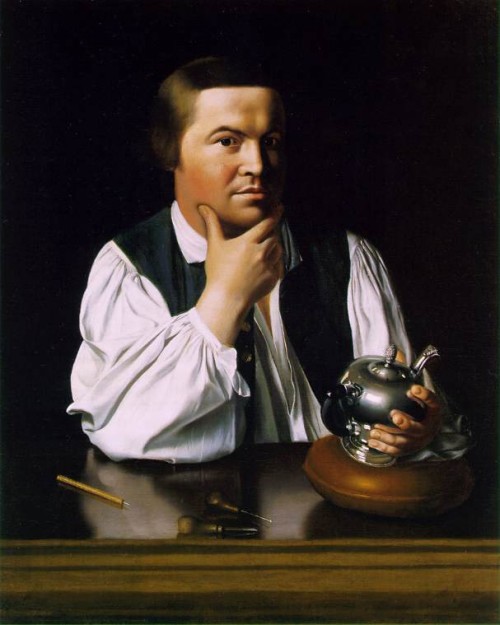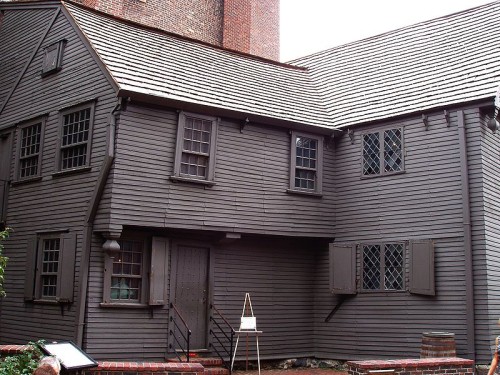“The regulars are coming! The regulars are coming!” shouted Paul Revere at the top of his lungs as he rode through town. At his call, minutemen armed themselves. The British armies were landing in Boston and coming by sea. They would be ready.
One If By Land and Two If By Sea
Two lanterns were lit the night of April 18, 1775 to announce that the British were coming by water, not really by sea. Two lanterns meant that the British would be crossing the Charles River.
So says Paul Revere’s own letter describing his midnight ride.
Revere had been notified by a friend who worked at the Old North Church. He lit lanterns to carry the message to the townspeople so they could be armed and ready to fight. His ride was not only to warn the townspeople, but also John Hancock and Samuel Adams, who were involved in the American movement.
Even though he is most known for his midnight ride, which is described in the poem “Paul Revere’s Ride” by Henry Wadsworth Longfellow, he had a vigorous life full of adventure and perils.
Paul Revere Biography

Paul Revere, painted by John Singleton Copley in 1768. The flowing sleeve is a political statement, as linen was forbidden to be made in the colonies.
Paul was named after his father who was a French Protestant and immigrant. His mother was Deborah Hichborn. He was born on January 1, 1735 in Boston, Massachusetts. Since Paul’s father was a gold and silversmith, he was trained at a young age in his father’s trade.
His father died when Paul was 19, and he took on the responsibility of the house and the care of his mother and siblings.
On August 17, 1757 he married Sarah Orne. He had eight children with her. Sarah died on May 3, 1773, and Paul married Rachel Walker five months later. He had eight more children with her.
During his lifetime he is said to have had an interest in copper engraving and experimented with it many times. He even made a bowl out of copper for the Sons of Liberty, a group of men against the Townshend Acts passed by Parliament and King George III.
Paul Revere’s Midnight Ride
Paul Revere was an adamant patriot and strong supporter of John Hancock, Thomas Jefferson, Benjamin Franklin, and others during that time. Before his memorable ride, Revere also participated in the Boston Tea Party, where the patriots threw British tea into the harbor.
After being alerted by the arrival of ships and by troop movements, Paul and some companions, who had been meeting secretly at the Green Dragon tavern in Boston, arranged their famous signal. “One if by land, and two if by sea” referred to lanterns in the north church steeple in Boston.
The signal came the night of April 18th, and Paul Revere rode gallantly through the streets of Massachusetts.
It was prearranged for Revere to ride to Lexington to warn John Hancock and Samuel Adams when the British were to come. So when the critical moment came Revere jumped upon his steed and rode towards Lexington, but not without stopping. He stopped at every house and warned the people that the British were coming and warned them to prepare themselves.
When he reached Lexington he roused Adams and Hancock and they escaped safely.
Before he left he was joined by another rider, William Dawes, sent to do the same task. Together the two of them decided to continues on to Concord. Concord had hidden ammunition for the continental army. On the way they were joined by a rider by the name Samuel Prescott.
Just before they reached Concord they were intercepted by a British battalion and all three were arrested.
Prescott escaped very quickly and continued on to Concord bearing their message. Dawes escaped shortly after. Revere was held for awhile then he was released, in time to see the ending of the battle at Lexington Green.
Revolutionary War, 1776–1779
Paul Revere went on to become a lieutenant colonel during the war, serving an undistinguished career. He was dismissed from the continental army in 1779, after the failed Penobscot expedition, for failing to follow orders. (He was later cleared of all charges by a military panel.)

Paul Revere’s house in Boston | Photo used with permission.
Later Years
After the Revolutionary War, Revere settled back into his life of being a silversmith, becoming a successful businessman.
He had many talents, one of the many unknown ones being that he became a dentist. There was a myth passed around that he had made George Washington’s dentures, but that’s not true. Even though he did do false teeth for some people—from ivory and animal teeth—his skill did not expound into making full sets of teeth.
He finally died on May 10th, 1818 of natural causes at the ripe, old age of eighty-three.
Despite vigilance and bravery of his companions, it is Paul Revere’s name that has carried through the generations, much of the credit for that due to Henry Wadsworth Longfellow’s famous poem, “Paul Revere’s Midnight Ride.”


